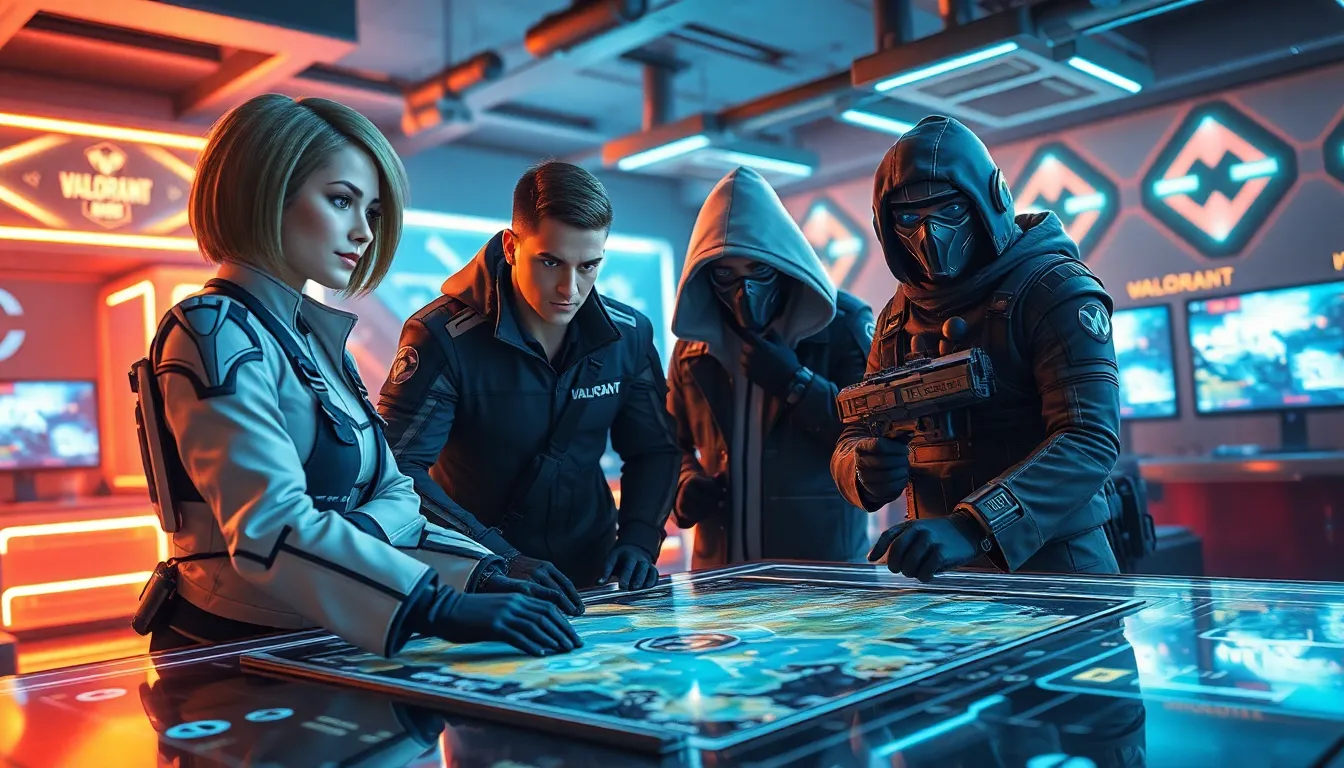In the fast-paced world of Valorant, choosing the right team composition can make or break a match. Think of it as assembling the Avengers—each character has unique abilities that can either save the day or lead to a spectacular flop. With the right mix of agents, players can unleash chaos on their opponents or execute the perfect strategy like a well-oiled machine.
Table of Contents
ToggleUnderstanding Valorant Team Comp
Valorant team composition significantly influences gameplay strategies. A balanced team maximizes strengths while minimizing weaknesses.
Importance of Team Composition
Team composition defines the synergy among agents. Choosing diverse agents enhances tactical options. A mix of duelists and controllers provides both aggression and map control. Support agents ensure team survival and effective healing. Creating a well-rounded team allows for adaptability during matches. Teams that prioritize diversity often outperform those with similar abilities. Well-structured compositions facilitate smooth execution of strategies, increasing the likelihood of victory.
Role Distribution in Teams
Each role in Valorant comes with distinct responsibilities. Duelists lead engagements and secure kills, so they drive offense. Initiators disrupt enemy strategies, making room for teammates. Controllers manage map control, using utility to shape fights. Sentinels provide defensive support, safeguarding teammates during skirmishes. Understanding role distribution helps players maximize agent capabilities. Teams benefit from clarity in roles, as it sets expectations and promotes coordination. Properly executed role allocation leads to more efficient teamwork and improved results.
Types of Valorant Team Comps

Team compositions in Valorant vary greatly and each type serves a unique strategic purpose. Understanding these categories assists players in forming effective teams.
Aggressive Compositions
Aggressive compositions focus on offense and aim to dominate early skirmishes. Duelists lead the charge, often selecting agents like Jett or Reyna for their high mobility and kill potential. Having multiple duelists can create a strong push, overwhelming opponents and establishing early map control. Utility is crucial; agents like Omen or Raze provide smoke screens and explosive tactics to aid in taking fights. Consideration should be given to supporting agents like Sage, who can heal and revive teammates. Such compositions thrive on quick, relentless engagements, making them effective in pressuring enemies.
Defensive Compositions
Defensive compositions emphasize strategy and control over aggression. Controllers like Viper or Brimstone play vital roles by denying areas with smoke and area-denial abilities. Sentinels, including Killjoy and Cypher, fortify team defense by deploying traps and monitoring flanks. This type aids in stabilizing sites during engagements, providing information and securing kills through effective positioning. Having a less aggressive approach allows for disciplined play, maximizing the chance of winning by countering enemy strategies. Coordinating utilities and site setups is crucial in adapting to enemy tactics.
Balanced Compositions
Balanced compositions blend offensive and defensive strategies for versatility. They often include a mix of duelists, controllers, and support agents, allowing for adaptability in various situations. Agents like Raze can initiate aggressive plays while Omen controls sightlines. Sentinel agents provide security and reassurance at key positions. This balance enables teams to either play aggressively or fall back as necessary. Players can pivot tactics based on enemy behavior, making such compositions favorable in unpredictable matches. Cohesion and communication become essential as team members need to adjust plays dynamically throughout the game.
Key Agents in Valorant Team Comp
Understanding the key agents in Valorant team composition enhances gameplay and strategy. Each agent’s unique abilities contribute to a team’s effectiveness.
Duelists
Duelists serve as the offensive backbone in Valorant. They excel in taking aggressive engagements, with agents like Jett and Reyna leading the charge. Jett’s mobility enables quick entries, while Reyna can thrive on securing frags for self-healing. These agents prioritize fragging and creating space for the team, making early picks crucial for building momentum. They also demand strong aim and positioning, as skilled duelists can turn the tide of a match rapidly.
Controllers
Controllers manage space and influence enemy movement through strategic abilities. Agents like Viper and Brimstone provide utility that can control areas effectively. Viper’s toxic screen can obstruct visibility, setting the stage for ambushes. Brimstone, with his smokes and orbital strike, offers significant area denial and can execute plays seamlessly. Prioritizing map control helps teams dictate engagements and protect objectives, showcasing how controllers lay the foundation for tactical gameplay.
Initiators
Initiators play a key role in breaking through enemy defenses and gathering crucial intelligence. With agents like Sova and Breach, they equip teams with the tools to initiate fights successfully. Sova’s recon abilities reveal enemy locations, allowing teammates to position themselves advantageously. Breach utilizes his abilities to blind opponents and facilitate team engagements. Prioritizing information-gathering and disruption provides teams with a tactical upper hand, promoting dynamic strategies.
Sentinels
Sentinels focus on support and defense, ensuring their team remains secure while controlling areas. Agents like Sage and Killjoy play vital roles in healing and fortifying positions. Sage’s healing ability can sustain teammates during engagements, while Killjoy’s turret offers reliable defensive measures. Prioritizing these roles ensures teams can withstand attacks and maintain map control. By combining defensive strategies with supportive gameplay, sentinels enhance overall team longevity during matches.
Tips for Building a Solid Valorant Team Comp
Building a solid team composition in Valorant hinges on effective communication and synergy among players.
Communication and Synergy
Strong communication forms the backbone of any successful team comp. Players should share information about enemy positions, abilities, and strategies throughout the match. Establishing clear role definitions helps ensure that agents perform their responsibilities. Coordinate ultimate abilities to maximize impact during critical moments. Foster an environment where team members feel comfortable sharing ideas and strategies. Frequent check-ins can help maintain awareness of each player’s status and intentions, promoting proactive decision-making on the battlefield.
Adapting to Opponents
Adapting to opponents plays a crucial role in achieving victory in Valorant. Assess enemy compositions early in the match to identify weaknesses. Counter their strategies by adjusting layered tactics based on their playstyle. Use the agents’ abilities strategically to exploit vulnerabilities while minimizing your own. Analyze their positioning and adjust accordingly; if opponents favor aggressive pushes, strengthen defensive structures. Flexibility allows a team to pivot strategies mid-game, enhancing overall effectiveness against varied opponents.
Mastering team composition in Valorant is crucial for achieving success in matches. A well-rounded mix of agents not only amplifies individual strengths but also fosters effective teamwork. By understanding the unique roles and abilities of each agent players can create strategies that adapt to any situation.
Whether opting for an aggressive approach or a more balanced strategy communication and synergy among team members remain key. As players refine their compositions and learn to counter enemy tactics they’ll find themselves better equipped to secure victories. Embracing the dynamics of team composition can turn the tide in any match, making it an essential aspect of gameplay.





